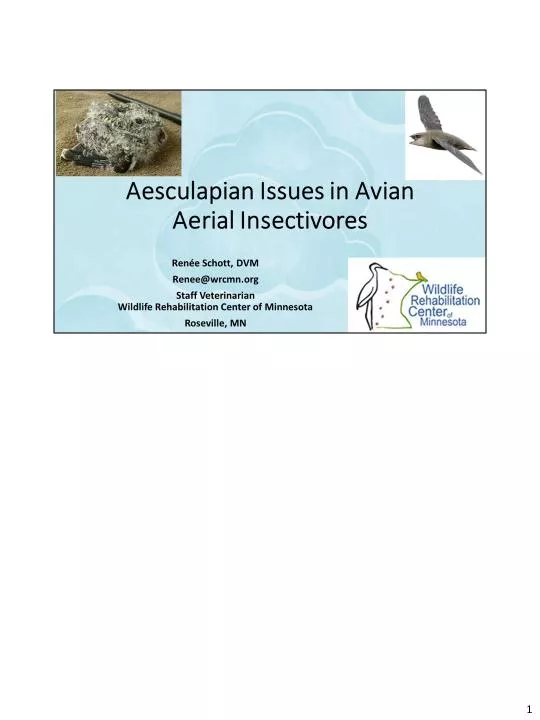/


1 2 3 nighthawk 4 So we have our history now what do we want to do with this patient Yes physical exam This is just a picture showing the difference between the juvenile and adult feather pigme ID: 297458
Download Pdf The PPT/PDF document "First of all, what species is this? Comm..." is the property of its rightful owner. Permission is granted to download and print the materials on this web site for personal, non-commercial use only, and to display it on your personal computer provided you do not modify the materials and that you retain all copyright notices contained in the materials. By downloading content from our website, you accept the terms of this agreement.
1 2 3 First of all, what species is this? Common nighthawk! 4 So we have our history, now what do we want to do with this patient? Yes, physical exam! This is just a picture showing the difference between the juvenile and adult feather pigmentation (adult is on your right, juvie on the left) 5 Physical exam findings are as above: 6 PE is done, now what do you want to do? Radiographs are definitely a great idea, howeve,r you can’t get him to your vet for 2 days͙͘so now what do you need to think about? Yes, supportive care! 7 The first few days after admission, we should be checking hydration twice daily to make sure the patient is maintain hydration, and/or making up for dehydration. Medications; I recommend a multimodal pain management protocol (meaning NSAID and opioid) but ultimately you’ll use whatever protocol you’ve worked out with your veterinarian. I see 185+ species each year, and some of them, sometimes, don’t get enough calcium in their diet to fix fractures ( ie pigeons, herons, ducks IME) so I’ve gotten into the habit of putting all fracatures are calcium CARBONATE. As long as you have calcium CARBONATE (no vit D or phosphorus added) you *can’t* overdose͘ 8 PE is done, now what do you want to do? Radiographs are definitely a great idea, however you can’t get him to your vet for 2 days͙͘so now what do you need to think about? Yes, supportive care 9 So what are some natural history considerations about nighthawks that would relate to keeping them in captivity? Look at that picture — does that bird look like he’s perching???? No!! Nighthawks stand flat ( when they land) and will prefer to sit on things that are brown (so they camouflage in) Because of their perching habits, or lack there of, their feet aren’t used to taking abuse - they have very sensitive feet and are prone to bumblefoot =soft substrate is imperative. Feathers are important for all birds but especially for those who eat on the wing — enclosures must not damage feathers. 10 What in CONIs natural history will help us figure out a do - able diet in captivity? Yes, they eat entirely on the wing! As much as robins would like us to think so, dog food is NOT an insect substitute. Look at the ingredients on the can — do these species of bird ever eat these ingredients in the wild — NO! Does your climate match their natural client http://www.arbico - organics.com/category/beneficial - insects - feeder - insects If long term, need supplements — anyone know why? If all they eat are insects, why can’t I just feet insects? 2 reasons͗ 1) we don’t even attempt to approach the number of different species of insects that CONIs eat on a regular basis. 2) Those insects all have full stomachs — and each species eats a huge variety of foods. What do you feed your feeder insects? Sweet potato and kale?wheat bran? Chick starter? Do you think that even broaches the number of different foods/ nutritnets that CONIs’ prey eats in the wild? No͘ 11 12 uill 13 14 15 16 17 abnormal 18 normal 19 20 21 22 Personal communication, Veronica Bowers 23 Per UK common swift organization, veronica bowers, our own experiences 24 25 26 27 When you extend the wings (as is normally done) on aerial avian insectivore VD radiographs, you sometimes can’t see coracoid fractures - so make sure to get two views (or have them radiograph with the wings not stretched out on the VD view) 28 29 30 31 http://www.commonswift.org/Veterinary - Help - for - Common - Swifts.html 32 33 34 35 36 37 38 39 40 http://www.commonswift.org/Veterinary - Help - for - Common - Swifts.html 41 Vit a/d http://valleyvet.naccvp.com/index.php?m=product_view_basic&u=country&p=msds &id=1058120 42 http://www.commonswift.org/Veterinary - Help - for - Common - Swifts.html 43 44 45 46 47 http://lauraerickson.blogspot.com/2012/02/rehabbing - nighthawks.html 48 49 50 51